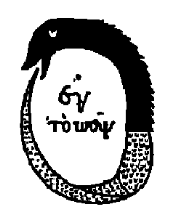
From the Chrysopoeia (Gold Making) of Cleopatra during the Alexandrian Period in Egypt (1st cent. B.C). The enclosed words mean "The All is One".
An Ouroboros is a Serpent biting its own tail. This symbol is first seen as early as 1600 years BC in Egypt during the twenty-first dynasty, on the papyrus of Dama Heroub. It shows up in alchemical texts such as Chrysopoeia (Gold making) and Codex Marcianus. From there it moved to the Phonecians and then to the Greeks, who called it the Ouroboros, which means "devouring its tail" and used it to symbolise the universe and the revolutions of the cosmos, an eternal cycle of destruction and renewal. The symbol of a serpent biting its tail is found in other mythoi as well, including Norse myth, where the serpent's name is Jörmungandr, and in Hindu, where the dragon circles the tortoise which supports the four elephants that carry the world.
The ouroboros has several meanings interwoven into it. Foremost the serpent biting, devouring, eating its own tail symbolises the cyclic Nature of the Universe: creation out of destruction, Life out of Death. The ouroboros eats its own tail to sustain its life, in an eternal cycle of renewal. In alchemy it symbolizes the balance between Night, Earth, and the destructive force of nature, yin and Day, Heaven, the generative, creative force, yang.
Worth noticing is that in early mythology the distinctions between words that describe dragons and snakes are often blurred, and are to some degree interchangeable. The old German word for dragon, "lindwurm", literally means "snake-worm" The ancient Anglo-Saxon word "wyrm" has been translated as meaning any of "dragon," "serpent," or "worm". Early pictorial representations of dragons were almost always shown as large snakes. Ancient dragons seeme as a rule to be described more like giant serpents. The Bible interchanges the words dragon and serpent liberally. See for example Job 41 [Warning: external link] for a good Biblical description of a dragon.
A